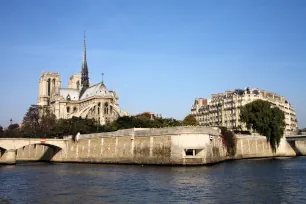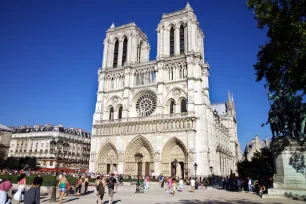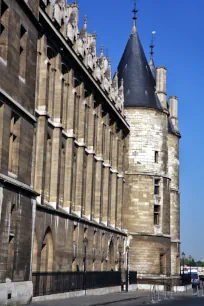Considered the heart of Paris, Île de la Cité is one of two natural islands that sits in the middle of the Seine. All distances in Paris are measured from the center of the island.
The Early Days of the Island




First settled by the Parisi Tribes, the Île de la Cité is probably the oldest settlement in the city of Paris, set up around the third century BC. In 52 AD, after being plundered by the Romans, the settlement was rebuilt as the Roman city of Lutetia. During the latter days of the Roman Empire, residents of the city sought refuge at the island from attacks by Nomadic tribes like the Huns.
Later, from the sixth through the fourteenth centuries, the kings of France lived on the Île de la Cité. A palace, constructed during Merovingian times (5th to 8th century AD), was built at the western end of the island, allowing the island to remain an important political center through the Middle Ages.
In the tenth century, a cathedral – one that would be the predecessor to the famous Notre Dame – was erected on the island.
Île de la Cité has always been linked to the Right and Left Banks of Paris by two bridges, the first ones made of wood and later rebuilt from stone. The Pont Neuf (New Bridge) still remains, having been constructed by the order of King Henry IV in 1607. It is now the oldest bridge in Paris. At the site where the two spans of the bridge connect stands an equestrian statue of Henry IV on the island near the bridge, first erected in 1618. It was destroyed during the French Revolution and then rebuilt again exactly two hundred years later.


Sights
The most famous landmark on the island and undoubtedly its focal point is the magnificent Notre-Dame Cathedral. Built between 1163 and 1345, it is the cathedral of Paris and the seat of the archbishop of the city.
Visitors will probably also want to check out the Palais de Justice (Palace of Justice), built in the eighteenth century to house the French equivalent of the Supreme Court. At this same site sat the early seat of Roman government, as well as the palace from the Gothic period. Part of the Palais contains a structure known as the Conciergerie, a former prison that housed Marie Antoinette before her execution.
Inside the new courtyard of the Palais de Justice is another magnificent church, Sainte-Chapelle. Completed in only five years, Sainte-Chapelle boasts some of the most magnificent stained-glass windows in the world, depicting the entire history of Christianity from Genesis to the crucifixion of Jesus. The Rose Window, added later, is thought to be a perfect example of the Flamboyant Gothic style. The church was built by order of King Louis IX to house religious relics, including what the king thought to be Christ’s crown of thorns that he wore on the cross.
Often overlooked by visitors is the oldest remaining residential quarter on the island, known as Ancien Cloître Quartier. Only partially intact, some of it was demolished in the 1860s. It’s also a treat to visit the small, uncrowded residential park known as the Place Dauphine. The small park is surrounded by expensive residences and a few shops and bistros.
- Next: Grand Palais
- More Sights & Attractions in Paris

